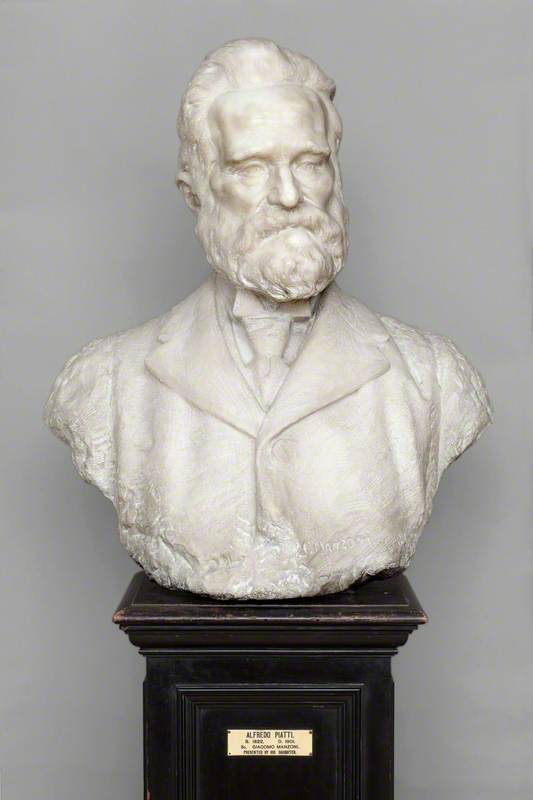
Carlo Alfredo Piatti (1822–1901) c.1898–1909
Giacomo Manzoni (of Bergamo) (1870–1910)
Royal Academy of Music
Manzoni was a north Italian carver and sculptor, born on 26th April 1870 at 43 Via Luprita in Calusco d'Adda, to the west of Bergamo. He was the third child and second son of Costanzo (sometimes Costante) Manzoni, then 41, and his wife Giovanna, daughter of Achille Filippini. He had an elder brother called Giacomo Achille (b.1866) and a sister, Elisa Antonia Catarina (b.1868). The latter may not have survived beyond childhood given that another Elisa (Giuseppa) was born in 1873 and Giulia Maria Clotilde followed in 1877, when the family also moved to 12 Via Luprita. Another son, Giorgio Enrico was born in 1882 but the children’s mother may have died before 1890 since in that year and 1893/1894 their father had another daughter (Elisa, d.1890) and son (Giovanni, d.1896) by Felicita Zonca, an unmarried countrywoman, possibly a servant.
Manzoni’s main output appears to have been as a church carver in wood and stone, including building and furniture decoration, and the carving of religious effigies. His earliest church work so far identified is decoration in SS. Fermo e Rustica at Presezzo (1893) and a side-altar figure of Saint Joseph (1897) for S. Fedele in his native Calusco, where he also did a Madonna, the Sacred Heart and Saint Louis for other side altars. Other churches with work by him from 1898 to his death include three in Bergamo (S. Alessandro, Santa Maria delle Grazie and S. Leonardo), Borgo di Terzo, Almennno, Endenna, Martinengo, Olera, Ponteranica, Albino, Grignano, Verdellino, and Grumello del Monte. The final forms of late exterior figures that he modelled for Albino (1903), Verdellino (1906) Presezzo (1910) and S. Leonardo, Bergamo (after 1900), were in cast concrete. In his spiritual memoirs, Pope John XXIII (Angelo Roncalli), who was born at Sotto il Monte, north-east of Calusco, mentions a Manzoni processional Madonna of the Assumption, given to its parish church, that was one of his early favourite icons. His, or more probably his editors’, attribution of it to Manzoni is apparently in error for local brothers of the same common name who were also church carvers.
In 1903 Manzoni exhibited a Pietà in plaster at the annual Carrara Academy exhibition and two more plasters at the National Exhibition held in Milan in 1906: a statue titled Dolore materno (Maternal grief), and a group called Ebbra d'amore (Intoxication of love). In 1906 he also won a competition for a medallion portrait on the tomb of the lawyer and politician Federico Maironi in Bergamo cemetery.
His most substantial currently known secular pieces are busts of the celebrated cellist Carlo Alfredo Piatti, also a native of Bergamo, both showing him in old age. Piatti divided his time between London and Italy and was a teacher at the Royal Academy of Music, London. His daughter, Rosa Costanza, herself a fine pianist, married Count Carlo Lochis of the local Bergamo family who were generous patrons of the Carrara Academy. From 1898, her father spent summer months in a villa at Cadenabbia on Lake Como and the rest of the year with her at Crocette di Mozzo, near Bergamo, and he was buried there in the Lochis family mausoleum. Either late in Piatti’s life, or posthumously, Manzoni made at least two marble busts of him and, in late 1909, Contessa Piatti-Lochis offered one to the RAM through the agency of the English cellist William Whitehouse, whom she called her father’s ‘favourite pupil and friend’ in a related letter to the Academy dated 1910.
A second, funded by public subscription and result of a competitive commission from the Art Circle in Bergamo, was unveiled in the lobby of its Teatro Donizetti on 21 April 1910, set up near a bust of the celebrated local tenor G. B. Rubini. Its associated inscription reads, ‘Ad Alfredo Piatti/ Bergamo e Londra/ Sorelle nel ricordo’ (‘sisters in remembrance’). What may be Manzoni’s plaster maquette for the theatre bust, or a preliminary model for both, is also in the Museo Donizettiano at Bergamo. There is another memorial bust in pale pink marble, made before March 1903, above Piatti’s gravestone in the Lochis mausoleum at Crocette di Mozzo: the building was reported in a neglected state in 1951 but has reportedly been used for at least one recent concert. Images show the bust is still there: it is apparently unsigned and without maker attribution, but Manzoni is an obvious contender.
Manzoni died at Bergamo on 31 July 1910, reportedly from cirrhosis of the liver of four months diagnosed duration. He was survived by a young wife (Narcisa) and his elder brother Achille. A brief press notice of his death appeared in the September issue of the Milan arts magazine Ars et Labor, mentioning the ‘very life-like’ quality of his Piatti bust in the Bergamo theatre.
He should not be confused with other Manzoni namesakes: Giacomo Manzoni, better known as Giacomo Manzù (1908–1991), also born in Bergamo who died at Ardea (Lazio); Giacomo Manzoni from Padua (1840–1912); and a sculptor/modeller called (Giovanni) Carlo Manzoni (1856–1910), born near Milan.
Summarised from Art UK's Art Detective discussion 'Is this by Giacomo Manzoni (active 1909 or earlier)? Could we find his birth and death dates, and examples of his work and signature?'
Text source: Art Detective
